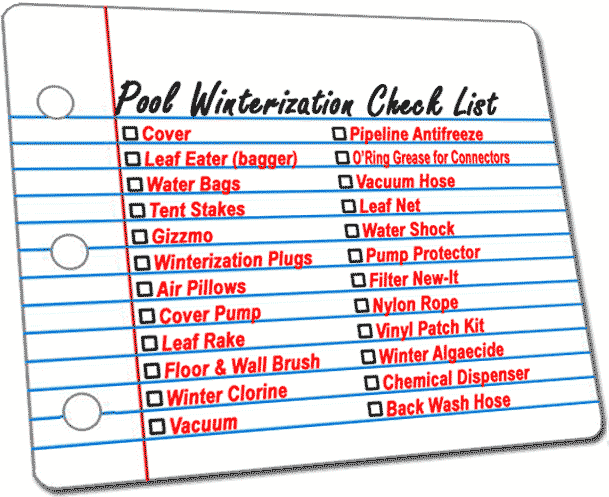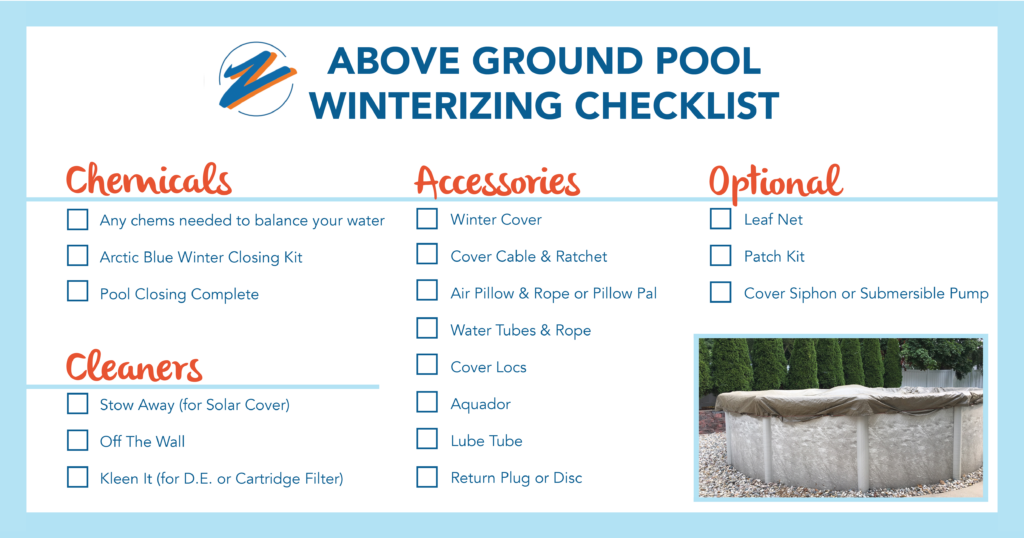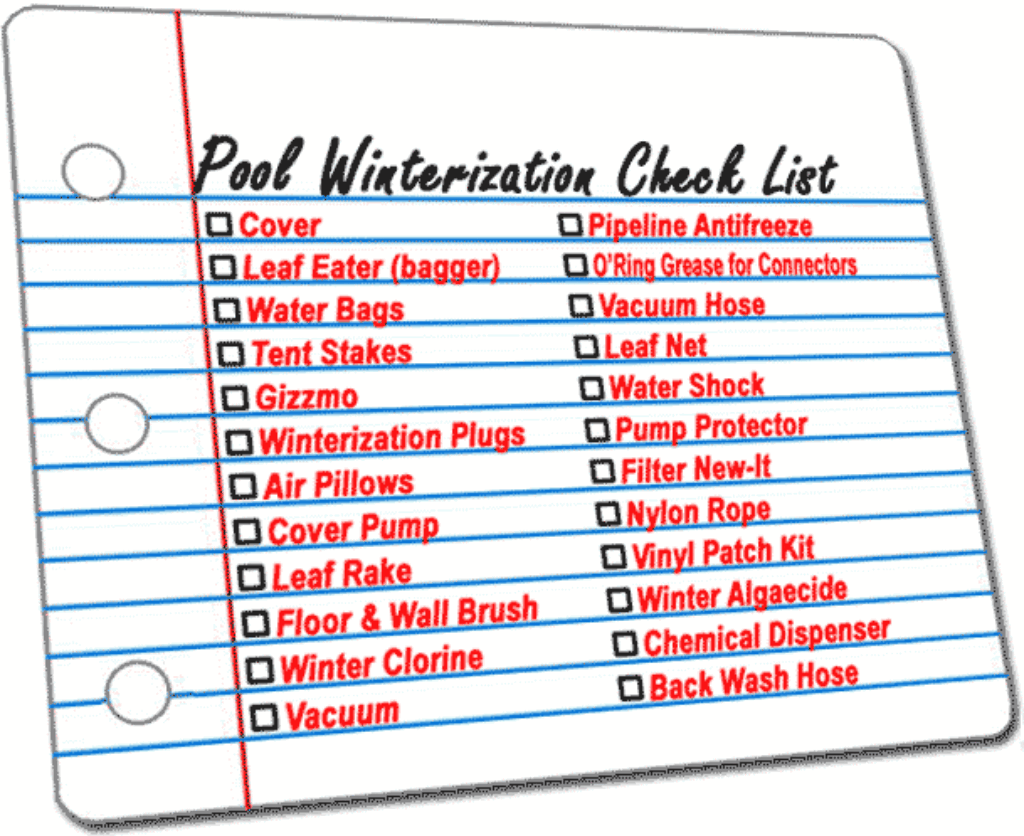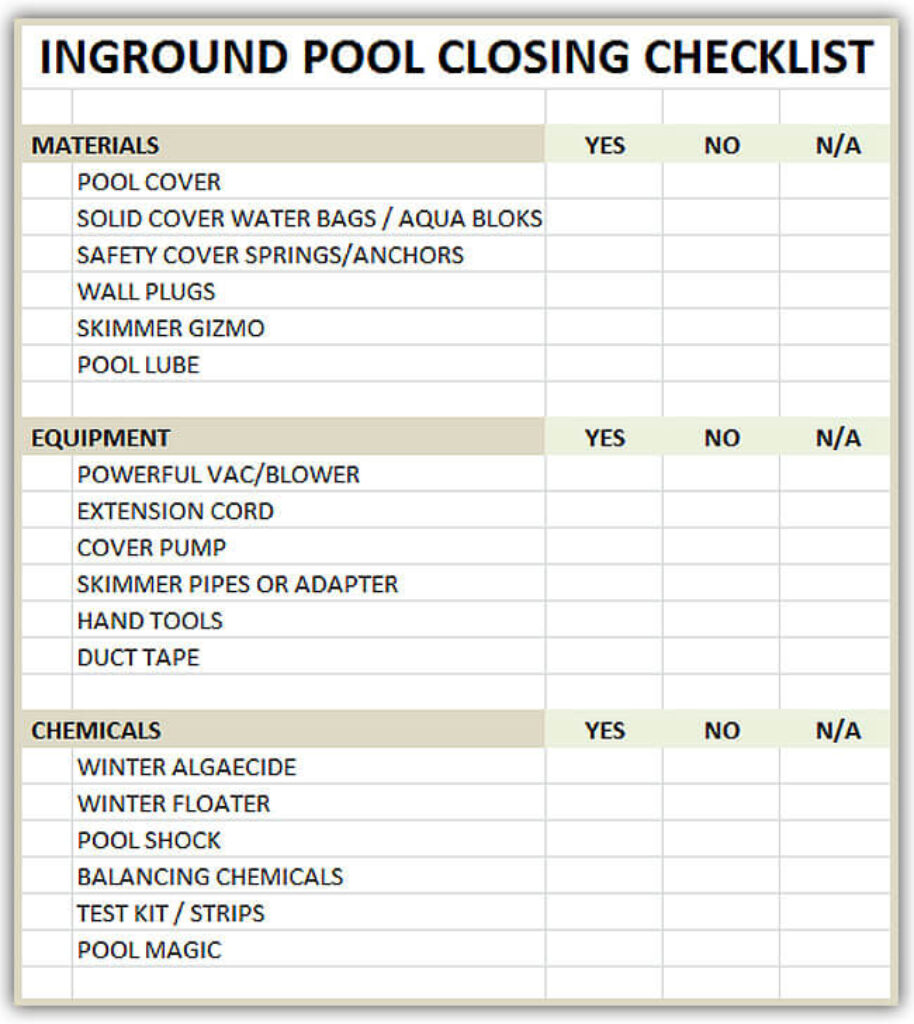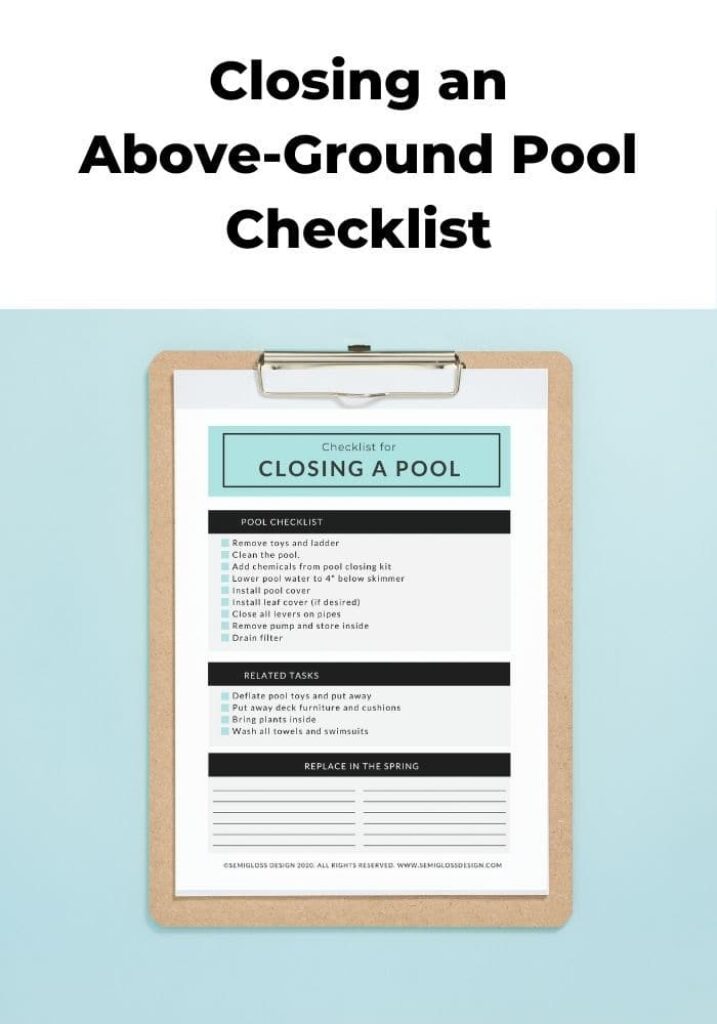If you own an above ground pool, preparing it for winter is essential to protect it from the harsh weather conditions. From draining the water to properly covering it, there are several steps you need to take to ensure your pool stays in excellent condition throughout the winter months. In this article, we will provide you with a complete checklist on how to winterize your above ground pool, covering everything from cleaning and maintenance to storing equipment and supplies. By following these steps, you’ll be able to enjoy a hassle-free reopening come springtime.
This image is property of www.zagerspoolspa.com.
Draining the Pool
Lowering the water level
Before you can start the winterization process for your above ground pool, you’ll need to lower the water level. This is an important step to prevent any potential damage to your pool and its accessories during the colder months. To lower the water level, you can use a submersible pump or a simple garden hose. Start by attaching the pump or hose to a drain spout or the pool’s filtration system. Then, let the water slowly drain until it reaches the desired level, which is typically below the skimmer.
Draining the pool
Once you’ve lowered the water level, it’s time to completely drain the pool. This step is crucial to prevent any water from freezing and causing damage to your pool’s structure. To drain the pool, you can use a submersible pump or a sump pump. Simply place the pump in the deepest part of the pool and let it run until all the water has been fully drained. Make sure to direct the water away from your house and any other structures to avoid flooding.
Cleaning the pool
Now that the pool is drained, it’s time to give it a thorough cleaning. Start by removing any debris, such as leaves or sticks, that may have accumulated at the bottom of the pool. You can use a pool net or a pool vacuum to help with this task. Once the debris is cleared, it’s important to brush the walls and floor of the pool to remove any algae or buildup. Use a pool brush to scrub the surfaces, paying extra attention to areas that are prone to algae growth. After brushing, you can use a pool vacuum to suck up any loosened debris.
Removing Pool Accessories
Removing ladders and handrails
One of the first pool accessories you’ll want to remove is the ladder or handrail. These items are typically detachable, making them easy to take off for the winter. Start by unscrewing any bolts or fasteners that hold the ladder or handrail in place. Once they’re loose, carefully lift the accessory out of the pool and set it aside for storage. Remember to clean and dry the ladder or handrail before storing it to prevent any mold or mildew growth.
Taking out pool toys and floats
If you have any pool toys or floats in your above ground pool, now is the time to remove them. Start by gathering all the items floating in the pool and place them on the pool deck. Give each toy or float a quick rinse with a hose to remove any dirt or debris. Once they’re clean, allow them to fully dry before storing them away for the winter. Consider using a waterproof storage bin or bag to protect them from moisture or pests while in storage.
Disassembling and storing pool pump/filters
The pool pump and filters are essential components of your above ground pool, and they need to be properly stored during the winter months. Start by turning off the power to the pump and drainage system. Next, disconnect the hoses and remove the pump and filter from their housing. Clean and dry each component thoroughly before storing them. If possible, store the pump and filter indoors to protect them from extreme temperatures. Otherwise, cover them with a waterproof cover that is securely fastened to prevent any water or debris from getting in.
Cleaning the Pool
Brushing the walls and floor
Once the pool has been drained and all accessories have been removed, it’s time to focus on cleaning the walls and floor. Start by using a pool brush to scrub the walls and floor of your above ground pool. This will help remove any algae or buildup that may have accumulated over time. Make sure to brush vigorously, paying extra attention to corners and crevices where algae tends to thrive. After brushing, use a pool net or vacuum to remove any loosened debris.
Vacuuming the pool
After brushing, it’s important to vacuum the pool to remove any remaining dirt or debris. There are different types of pool vacuums available, such as manual vacuums or automatic robotic vacuums. Choose the option that works best for you and follow the manufacturer’s instructions for proper use. When vacuuming, make sure to cover the entire pool surface, including the walls and floor. Take your time to ensure a thorough cleaning and remember to clean or replace the vacuum filter as needed.
Using pool cleaner or algaecide
To maintain crystal-clear water throughout the winter, consider adding a pool cleaner or algaecide to your above ground pool. These products help prevent the growth of algae and keep the pool water clean and balanced. Follow the instructions on the product packaging for proper dosage and application. Generally, you’ll need to distribute the cleaner or algaecide evenly across the pool surface, either by pouring it directly or using a dispenser. Allow the product to circulate in the pool for the recommended time before proceeding with the next steps of winterizing.
Balancing Pool Chemistry
Testing the water chemistry
Maintaining proper pool chemistry is crucial for the overall health and cleanliness of your above ground pool. Before winterizing, it’s important to test the water chemistry to ensure it’s properly balanced. You can use a pool water testing kit or take a water sample to your local pool store for analysis. The main parameters to check are pH and alkalinity levels, as well as chlorine or other sanitizer levels. The ideal ranges may vary depending on the type of pool and the chemicals you use, so refer to the manufacturer’s recommendations or seek professional advice.
Adjusting pH and alkalinity levels
If the water chemistry test reveals that the pH and alkalinity levels are not within the recommended range, you’ll need to make adjustments. To raise the pH and alkalinity levels, you can use a pH increaser or alkalinity increaser, following the manufacturer’s instructions for proper dosage. Conversely, if the levels are too high, you’ll need to lower them using a pH decreaser or alkalinity reducer. It’s important to achieve the correct balance to prevent equipment damage and ensure optimum water quality during winter.
Adding winterizing chemicals
Once the water chemistry is properly balanced, it’s time to add winterizing chemicals to your above ground pool. These chemicals help protect the pool and equipment from potential damage during the winter months. The most common winterizing chemical is a winter algaecide, which helps prevent algae growth and keeps the water clear. Follow the manufacturer’s instructions for proper dosage and application. It’s important to add these chemicals a few days before covering the pool to allow sufficient time for them to circulate and take effect.
This image is property of www.pelicanshops.com.
Winterizing Pool Equipment
Lowering the water level in the equipment
When winterizing your above ground pool, it’s essential to properly prepare the pool equipment for the colder months. Start by lowering the water level in the equipment, such as the pump and filter. To do this, turn off the power to the equipment and open the drain plugs or valves. Allow the water to slowly drain out until the level is below the openings. This will prevent any water from freezing and causing damage to the equipment.
Draining and disconnecting hoses
After lowering the water level in the equipment, it’s time to drain and disconnect the hoses. Start by removing any clamps or fasteners that attach the hoses to the pool equipment. Next, allow the water in the hoses to drain out completely. This is important to prevent any leftover water from freezing and causing damage. Once the hoses are drained, disconnect them from the equipment and store them in a dry and protected area for the winter.
Removing and storing pool pump/filters
To protect your pool pump and filter from potential damage during the winter, it’s best to remove and store them. Start by turning off the power to the pump and filter system. Next, remove any bolts or fasteners that secure the equipment in place. Carefully lift the pump and filter out of their housing and place them on a clean and dry surface. Clean the equipment thoroughly and ensure they are completely dry before storing them in a safe and protected area.
Covering the Pool
Preparing the pool cover
Before covering your above ground pool, make sure the cover is clean and free from debris. Brush off any dirt or leaves that may have accumulated on the cover surface. If there are any rips or tears, it’s important to repair or replace the cover before proceeding. Remove any excess water or snow from the cover to prevent it from sagging or collapsing during the winter.
Removing leaves and debris
To ensure a clean and secure cover, it’s important to remove any leaves or debris that may have fallen into your above ground pool. Use a pool net or skimmer to gather any floating debris and remove it from the pool. If there is substantial debris at the bottom, you may need to use a pool vacuum to clean it thoroughly. Removing leaves and debris will prevent them from decomposing and potentially causing water contamination or damage to the pool structure.
Securing the cover with water bags or weights
Once the pool is clean and free from debris, it’s time to secure the cover in place. Above ground pool covers are typically held down with water bags or weights. Start by positioning the cover over the pool, ensuring it’s centered and fully covers the surface. Next, fill water bags or containers with clean water and place them along the pool’s edge to hold the cover down. Alternatively, you can use cover weights specifically designed for this purpose. Make sure the cover is evenly secured to prevent it from being blown off by strong winds or heavy snow.
This image is property of blog.intheswim.com.
Protecting Pool Plumbing
Blowing out the plumbing lines
To protect your above ground pool’s plumbing from freezing and potential damage, it’s important to blow out the lines before winter. Start by turning off the power to the pool equipment. Then, remove the drain plugs from the pump, filter, and any other equipment that has a drain. Use a shop vacuum or an air compressor with a blowout attachment to remove the excess water from the plumbing lines. Blow air into the lines until no more water comes out, ensuring they are fully cleared.
Adding antifreeze if needed
In areas with extremely cold temperatures, it may be necessary to add antifreeze to the pool’s plumbing lines for extra protection. After blowing out the lines, pour a sufficient amount of pool antifreeze into the lines to ensure they are thoroughly protected. This will help prevent any remaining water from freezing and causing damage to the plumbing. Be sure to use antifreeze specifically designed for pools and follow the manufacturer’s instructions for proper use and dosage.
Closing the skimmer and return lines
To complete the protection of your above ground pool’s plumbing, it’s important to close the skimmer and return lines. Start by inserting winterizing plugs or gizmos into the skimmer and return openings. These plugs create a seal and prevent water from entering the lines. Make sure the plugs are firmly in place to ensure a watertight seal. This step is crucial to prevent any water from freezing and causing damage to the plumbing system.
Maintaining Water Level
Using a pool cover pump
During the winter months, it’s important to maintain the water level in your above ground pool. Excess water or snow buildup can put pressure on the pool cover and potentially cause damage. To prevent this, use a pool cover pump to remove any standing water from the cover. Place the pump on the cover and allow it to remove the water automatically. Regularly check the pool cover pump and empty it as needed to maintain a safe water level on the cover.
Monitoring water level periodically
In addition to using a pool cover pump, it’s important to periodically check the water level in your above ground pool throughout the winter. Extreme weather conditions or evaporation can cause the water level to drop. Use a pool water level indicator or simply visually inspect the water level to ensure it remains at a safe level. If the water level is too low, add water as necessary to prevent potential damage to the pool structure.
Adding water when necessary
If you notice that the water level in your above ground pool is lower than the recommended level, it’s important to add water. This will help maintain the stability and structural integrity of the pool during the winter months. Use a garden hose or other water source to slowly add water until the desired level is reached. Avoid overfilling the pool, as this can put unnecessary strain on the pool cover and potentially cause damage.
This image is property of www.semiglossdesign.com.
Regular Maintenance during Winter
Removing debris from cover
Throughout the winter, it’s important to regularly remove any debris that may accumulate on your above ground pool cover. Use a pool net or a gentle broom to gently brush off any leaves, snow, or other debris. This will prevent the cover from sagging or collapsing under the weight and ensure proper protection for your pool during the winter months.
Checking and tightening pool cover periodically
To ensure the effectiveness of your above ground pool cover, it’s important to periodically check and tighten it as needed. Over time, the cover may loosen or become dislodged due to wind or other factors. Inspect the cover regularly and tighten any straps or fasteners that may have come loose. This will ensure that the cover remains securely in place and provides the necessary protection for your pool.
Inspecting pool equipment for damage
While your above ground pool may be out of use during the winter, it’s important to periodically inspect the pool equipment for any potential damage. Check the pump, filter, hoses, and other components for any signs of wear or leaks. If you notice any issues, take the necessary steps to repair or replace the damaged parts. Early detection and maintenance can help prevent costly repairs or replacements in the future.
Spring Opening Preparation
Removing and cleaning pool cover
As the winter comes to an end, it’s time to prepare your above ground pool for the spring reopening. Start by removing the pool cover, taking care not to let any debris or water on the cover fall into the pool. Once the cover is removed, give it a thorough cleaning to remove any dirt or debris that may have accumulated during the winter. If the cover is damaged beyond repair, consider replacing it before reopening the pool.
Refilling the pool
After the pool cover is removed, it’s time to refill your above ground pool. Use a garden hose or other water source to slowly add water to the pool until it reaches the desired level. Make sure to monitor the water level closely to avoid overfilling. Once the pool is filled, turn on the power to the pump and filter system and check for any leaks or issues.
Reinstalling pool equipment and accessories
The final step in preparing your above ground pool for the spring is to reinstall the pool equipment and accessories. Start by connecting the hoses and reassembling the pump and filter system. Make sure all the connections are tight and secure to prevent leaks. Next, reinstall the ladder or handrail, ensuring it is properly fastened and sturdy. Finally, place any pool toys or floats back into the pool, making sure they are clean and in good condition.
Congratulations! You have now completed the comprehensive winterization and spring reopening process for your above ground pool. By following this complete checklist, you can ensure the longevity and optimal performance of your pool throughout the changing seasons. Remember to always carefully read and follow the manufacturer’s instructions for specific pool models and chemicals used. Enjoy a worry-free winter and a refreshing spring swim in your well-maintained above ground pool!
